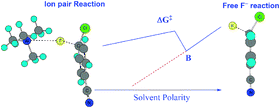Effects of ion-pairing and hydration on the SNAr reaction of the F− with p-chlorobenzonitrile in aprotic solvents†
Abstract
Theoretical ab initio calculations including liquid phase optimizations were used to investigate the

* Corresponding authors
a
Departamento de Ciências Naturais, Universidade Federal de São João del-Rei, 36301-160, São João del-Rei, MG, Brazil
E-mail:
josef@netuno.qui.ufmg.br
b
Departamento de Química, Universidade Federal de Minas Gerais, 31270-901, Belo Horizonte, MG, Brazil
E-mail:
dorila@zeus.qui.ufmg.br
Theoretical ab initio calculations including liquid phase optimizations were used to investigate the

 Please wait while we load your content...
Something went wrong. Try again?
Please wait while we load your content...
Something went wrong. Try again?
J. R. Pliego, Jr and D. Piló-Veloso, Phys. Chem. Chem. Phys., 2008, 10, 1118 DOI: 10.1039/B716159J
To request permission to reproduce material from this article, please go to the Copyright Clearance Center request page.
If you are an author contributing to an RSC publication, you do not need to request permission provided correct acknowledgement is given.
If you are the author of this article, you do not need to request permission to reproduce figures and diagrams provided correct acknowledgement is given. If you want to reproduce the whole article in a third-party publication (excluding your thesis/dissertation for which permission is not required) please go to the Copyright Clearance Center request page.
Read more about how to correctly acknowledge RSC content.
 Fetching data from CrossRef.
Fetching data from CrossRef.
This may take some time to load.
Loading related content
